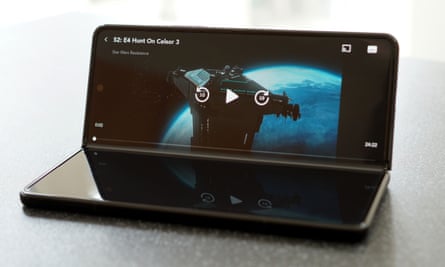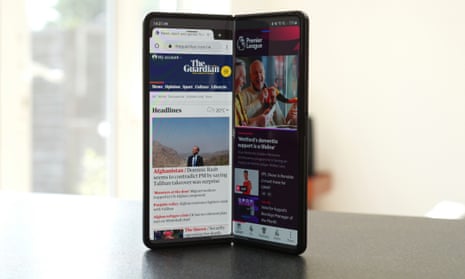Samsung’s third-generation folding phone-tablet hybrid is a technological marvel – faster, more refined than its predecessor and will even survive being dropped in the bath. But is the public ready for foldable phones?
The Galaxy Z Fold 3 costs £1,599 ($1,799/A$2,499), which is £200 cheaper than last year’s model, although still very expensive. It joins the £949 Galaxy Z Flip 3 and £1,149 Galaxy S21 Ultra at the top of Samsung’s smartphone line.
The Fold 3’s form and function are similar to last year’s Galaxy Z Fold 2, just 12g lighter and a bit slimmer in all directions. But the premise is the same – a tall, narrow screen on the outside with the device opening up like a book to one larger internal screen.
Typing on its narrow outside width takes a little practice but it is otherwise comfortable to use closed for typical daily tasks such as messaging and checking the train times.
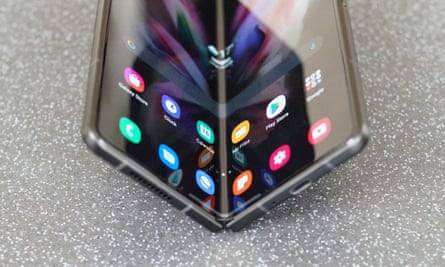
Opening the phone like a book reveals the fantastic flexible 7.6in OLED screen for tablet-like activities, such as watching movies, reading a book or using two apps side by side. The internal screen is much smoother to the touch than the Fold 2, allowing your fingers to glide over its surface more easily.
The hinge can hold the phone flat or at a range of angles, which means you can stand it up on its end or side for watching video or similar.
The screen is still softer than a traditional hardened-glass smartphone screen, so you have to be a little more careful when it is open. But it is robust enough to use Samsung’s S Pen stylus, which makes it work like a tablet-sized Galaxy Note for sketching, marking up documents or handwriting notes. The stylus costs £44 and is not included in the box, though.
The new IPX8 water resistance rating is a big durability upgrade and means it will survive dunks into water up to 1.5 metres deep. In short, you don’t have to worry about it getting wet.
Dust could still be an issue, but long-term testing of the Fold 2 showed the phone was up to the task of daily use.
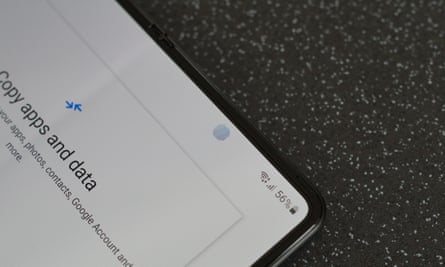
Specifications
Main screen: 7.6in QXGA+ Dynamic Amoled 2X Infinity Flex Display (374ppi)
Cover screen: 6.2in HD+ Dynamic Amoled 2X (387ppi)
Processor: Qualcomm Snapdragon 888
RAM: 12GB of RAM
Storage: 256 or 512GB
Operating system: One UI 3.1 based on Android 11
Camera: Triple rear 12MP: wide angle, ultra-wide angle, 2x telephoto; 10MP and 4MP selfie cameras
Connectivity: 5G, dual sim, USB-C, wifi 6, NFC, Bluetooth 5.2, UWB and location
Water resistance: IPX8 (1.5 metres for 30 minutes)
Dimensions folded: 158.2 x 67.1 x 16.0mm
Dimensions unfolded: 158.2 x 128.1 x 6.4mm
Weight: 271g
Faster and smoother
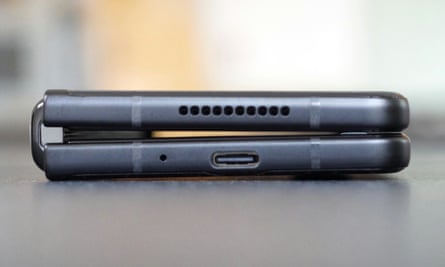
The Fold 3 has Qualcomm’s latest Snapdragon 888 chip. It matches the performance of the S21 Ultra, the Flip 3 and the OnePlus 9 Pro and other top Android phones, feeling noticeably snappier, faster to unlock and smoother in use than its predecessor.
Battery life is more variable than a regular smartphone. Light use primarily on the outside screen will see the phone easily last two days. A mix of using both screens for messaging, reading, general productivity, watching a bit of video and shooting a few photos will see the Fold 3 last closer to 35 hours, which is slightly longer than its predecessor. Even on heavy-use days it manages to last at least a day, although battery life is significantly shortened when using the always-on display mode.
Sustainability

Samsung does not provide an expected lifespan for the batteries in the Fold 3. Those in similar devices typically maintain at least 80% of their original capacity for at least 500 full charge cycles.
The phone is generally repairable. Screen repairs cost no more than £409 for the internal display or £109 for the cover display, while the battery is replaceable by authorised service centres.
Samsung offers trade-in and recycling schemes for old devices but the smartphone does not include any recycled materials. The company publishes annual sustainability reports but not impact assessments for individual products. The Fold 3 does not ship with a charger or earphones, just a USB-C cable.
One UI 3.1

Samsung’s custom version of Android 11, One UI 3.1, has been refined significantly to take advantage of the large internal screen.
Closed, the Fold 3 behaves just like a regular phone. Open it and you can select up to three apps from the recently used apps menu to use in a split-screen configuration. You can save your favourite combinations of apps to a multitasking menu for quick access, too.
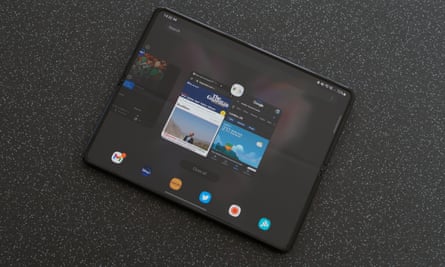
You resize the windows by dragging the little two and three-dot handles that separate the apps. The whole split-screen experience feels more refined and is a definite advance on previous efforts.
Many more apps take proper advantage of the large internal screen, too, such as the two-column settings app, Google’s Photos, Maps, Gmail and the discover feed. Third-party apps such as Evernote have started displaying multi-panelled interfaces too, all of which makes the internal screen more like a tablet and feeling less like just a blown-up phone screen.
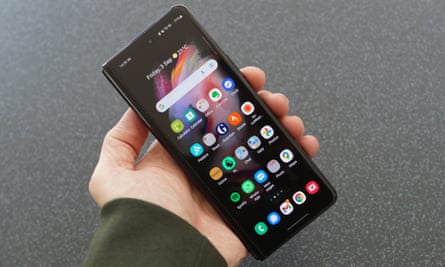
Most of the other unique software features from the Fold 2 are carried over. The app you’re using on the outside screen can switch to the inside one when you open it and visa versa. But if you leave this feature off, locking the phone by shutting it is really satisfying.
The Fold 3 will receive at least four years of software updates from release, including monthly security patches, making it one of the longest-lasting Android devices available, but about a year or so behind Apple’s five-year-plus support for its iPhones.
Five cameras
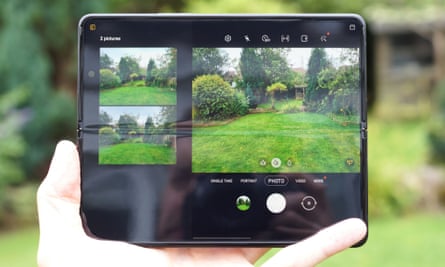
The Fold 3 has a triple 12MP camera system on the back, a 10MP selfie camera on the front and an additional 4MP selfie camera hidden under the top right of the internal screen.
The main rear camera is excellent. It is essentially the same as that fitted to the S21+ and keeps up with the competition, including improved low-light performance compared with its predecessor. The ultrawide camera produces good images in bright conditions but suffers a bit of grain in lower light levels. The 2x optical telephoto camera is solid with usable digital zoom up to about 5x. It can’t compete with optical zooms up to 10x, such as that on the S21 Ultra, however.
The outside selfie camera is excellent, producing good detail down to reasonably dim light, but struggles a bit with backlighting. The under-display selfie camera is certainly impressive technology by blending more seamlessly into the device, but photos lack detail with noticeable grain – best confined to use for video calls.
Overall, the cameras on the Fold 3 are a marked step up over last year’s model and compete well with all but the best cameraphones on the market.
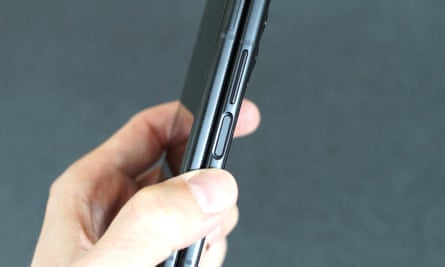
Price
The Samsung Galaxy Z Fold 3 costs £1,599 ($1,799/A$2,499) with 256GB of storage or £1,699 with 512GB.
For comparison, the Galaxy Z Flip 3 costs £949, the Galaxy S21 Ultra costs £1,149, the Galaxy S21+ costs £949, the OnePlus 9 Pro costs £829 and the iPhone 12 Pro Max costs £1,099.
Verdict
The Galaxy Z Fold 3 is a genuine technological marvel from Samsung.
The South Korean firm has improved almost everything with its third-generation folding tablet-phone hybrid. It is faster, smoother, has much improved software, better cameras, a more reliable fingerprint scanner and is £200 cheaper – although still very expensive.
Water resistance is a big step forward for durability. The technology behind it feels more mature while still being the most exciting cutting-edge device available. Stylus support is an added bonus that won’t be for everyone, but for Galaxy Note fans this is the powerhouse replacement for you.
There’s still a crease in the screen and the display remains soft and must be treated with more care. But the biggest issue for the Fold 3 is that it is an on-the-go device, at a time when many of us are stuck at home – a tablet that fits in your pocket is far more useful when you’re out of the house, at work, on the commute or sharing videos with friends. At home, there is usually a bigger and better display within arm’s reach.
Pros: a phone and tablet in one, water resistance, useful split-screen apps, great cover screen, fantastic tablet screen, top performance, good battery life, good cameras, head-turning design, S Pen support.
Cons: very expensive, no 5x optical zoom camera, internal screen can be marked more easily than traditional glass, heavy, thick.
